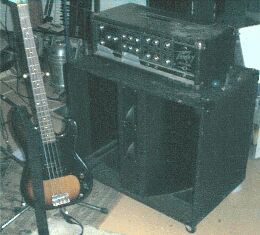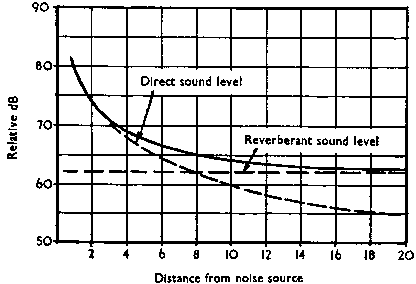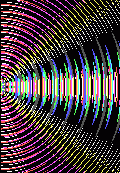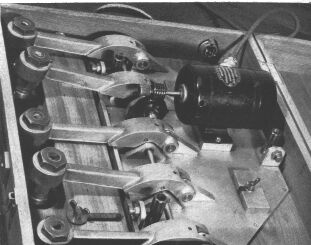Where the Quoll gets into the chook pen...
“Come into the bathroom” said Eric, guitar in hand.
So we tried out some of his lovely collection sitting on the side of the bath.
The bathroom is normally the last place you would think of taking a precious instrument, all hard and potentially wet. But it was exactly the hard of reflective walls that Eric was looking for.
Why do kids sing in the toilet, or adults in the shower, or people whistle in stairwells?
It's all got to do with echos and resonances, and every enclosed space, even if only on two sides, has its own sound properties that differ from free space.
Free space is when you are playing suspended from a balloon. Not very practical. So we tend to think of the ideal case being a half-sphere, strumming away sitting on a stool in the middle of a very large flat paddock, not a tree in view.
We are taught that sound proceeds in waves from the speaker, human or mechanical, to our ears. This is true in free space, but even standing in a paddock there will also be reflections, echos, from the ground, and these reflections will take a longer time to get to your ear than the direct wave.
If the speaker and listener are face-to-face the difference in sound path length will be greatest and the difference in strength or amplitude will also be greatest.
But when the speaker and listener are some distance apart the differences in time and amplitude between the direct and reflected paths will be very small. As a result one set of harmonically related frequencies will be cancelled out at the listener, conversly others reinforced.
Even under this “ideal” situation we now have distortion entering the picture, what the speaker uttered is not exactly what the listener heard. What you hear depends on where you are standing.
Okay, so now having calibrated our ears to windless dead silence and (almost) no reflected sound at all, let's go to the pub.
Out the back is the venue the publican added on a while back for bands, but it hasn't been successful, crowds fell away rapidly, there were noise complaints, and the bands prefer to play in the lounge. Being musos we grab our drinks and stroll in for a look.
The room is large, 20 metres long, 10 metres wide, and 5 metres high to the flat roof. The floor is sealed concrete, the ends and one side are brick, and the other side is all glass. There is a high stage at one end.
One of the first things you notice is that if you are more than a couple of metres away from somebody you can no longer understand what they are saying. It's loud enough, just scrambled and impossible to understand. Intelligibility drops to zero. You clap your hands sharply(*) and there is a lingering ringing that seems to resolve to a note, or is it notes? And lingers forever, or is it being re-excited simply by our talking quietly together?
So, standing only a few meters away, if you can't understand the speaker, what are you actually hearing?
Reflections off the hard surfaces surrounding you, and since the reflections can themselves reflect again, certain paths and frequencies can dominate. When reflections bounce back and forth between two flat surfaces the result is a resonance.
In this case the room size is 1:2:4 so the fundamental resonances will be harmonics of each other and reinforce. These resonant modes of a space are called its eigentones. (Recording studios are made odd shapes and ratios to spread these room eigentones).
What this means is that even a small distance from a sound source in a live or reverberant surrounding what you are hearing are the eigentones of the room that have been excited, and little of the direct sound from the source itself. For a backline guitar amplifier this sonic transition can occur before the edge of the stage, and since the room sonics carry it on from there, they become very important.
From the back of the room what you hear of the guitar amp is more images reflected off various surfaces than direct sound, and if sound were visible it would look like a kaleidoscope. What you hear depends on where you are standing.
Back in the bar we are introduced to one of the local musicians. When the publican is out of earshot he tells us the room has gained a terrible reputation with local bands.
“It's that far wall” he complains, “every time we start up another band starts playing the same song at the other end, a beat behind, and somehow they always seem to be louder. We have to turn right up to ride over the reverberation.”
This is like a bird fighting its reflection in a mirror, only worse because the room resonances store the energy being thrown at them and return it in full measure.
Turning up seems to be a natural reaction to “ride over it” because that's what musios and mixers do, but it's exactly the wrong thing to do, it only feeds the monster.
To avoid feeding the monster all sound should be directed down into the audience and away from the space over their heads, as much as possible, and the overall level has to be kept as low as possible. Getting down off the high stage and playing on the floor, and off the centre-line in a corner aimed straight into the audience won't cover it as well, but it will sound a hell of a lot better where it can be heard.
So we take our Moody (or whatever) back out into the paddock with a very long extension lead. But even with a mob of sheep between you and the amp to absorb ground reflection there is still something not right. As you move from side to side the trebles seem to come and go.
You got rid of all the reflections, so now what's wrong?
Interference. Your amp has two speakers side-by-side radiating in phase, and as you walk across the front it sounds a bit like dragging a stick along a picket fence.
Effectively the distance from your ear to each speaker is changing, and for each difference in distance there is a frequency that will be cancelled. Turning the cabinet on its side simply translates the picket fence to the vertical plane. In columns more than about four speakers high this becomes a serious problem.
Now I pose a key question:
when you are listening to an amp, what are you actually listening to?
When I'm mixing I frequently move around the room sampling the sound with my ears, with one eye on the SPL meter, aiming for the best average mix across the venue. When you mix the same band for years the variability of venues and their impact on the band sound, sometimes profoundly awful, becomes very obvious.
Okay, back in the paddock we've got a single speaker amp and put it up on a stand, and sitting right in front of the speaker on a tall stool. When the sheep shut up we can now hear what's really going on with amplifier tone.
That is, after the speaker and cabinet have done with it.
Building the Siamese W-bin gave me an opportunity to listen to, and measure, a 15-inch driver I had used a lot in its commercial small ported cabinet, and directly compare it in a W-bin (folded horn cabinet).

In a paddock.
The difference wasn't dramatic, it was stunning, both on instruments and the chest. A huge lift in dBSPL per watt and a subjective improvement in clarity and transparency, that sonic details from the bass guitar itself were more apparent, more faithful, and that the low-E was physical, the actual note and not third harmonic as in most cabinets.
So the cabinet has a large influence on what you hear.
At one point we re-speakered the PA with tougher speakers with a higher dBSPL rating. The difference was only small, but again there was a gain in clarity and sonic definition, instruments and voices sounded more life-like.
So the speaker (driver) also has an influence over what you hear, but by itself it's fairly small.
Now we come to the output of the amplifier and things get a little more complicated for guitar.
Hi-Fi amps avoid overload, clipping, at all costs. Guitarists on the other hand use small amps so they can shred without being too loud! Guitar amps have overdrive knobs and switches to drive the output stage nuts, deep into clipping.
It gets interesting for the engineer too because amplifiers are considered as linear systems and not a lot of attention is paid generally to what happens in overdrive. There is a lot of debate about Negative Feedback (NFB) and its role in amplifier sound, but an important point has been overlooked.
Negative Feedback is a “good thing”, but it only applies when the amplifier is in its linear region. Once driven to clipping the NFB loop is effectively open and so the benefits of NFB are lost.
One of these benefits is a lowering of amplifier output impedance, and a low output impedance is good because it provides dynamic braking or damping to the loudspeaker cone.
The Valve Amp vs. Transistor Amp debate takes on a new aspect when you realise that the main difference between them is the output transformer. In fact to transformer, or not to transformer, is the question of more significance than the driving devices.
Incidentally, when a conventional transistor saturates it's gain doesn't fall to zero, rather to a very low value and changes sign (“phase”), potentially making negative feedback positive. This little written about effect is called collector-following.
When any amplifier clips the NFB is lost while it does, but transformer and non-transformer amps react differently to clipping.
When a transformerless amp clips the speaker is connected to one of its supply rails for the duration of the clip. This causes Hi-Fi buffs to worry about their speakers catching fire, but for our consideration all that is important is understanding that the supply rails are AC ground, and that during clip the speaker is therefore effectively shorted and thus damped.
In a transformer amp things are quite different. By its nature a transformer only transforms a changing signal, and during clip the signal isn't changing, it's flat-topped or DC (dv/dt = 0). The amplifier output resistance jumps from milliohms to ohms and damping is greatly reduced. During this time the loudspeaker is fairly effectively disconnected from the amplifer and stored energy is allowed to do its own thing in interaction with its cabinet.
There is a line of opinion that the amount of NFB applied in transformer amps (12-15dB) and non-transformer amps (30-40dB) is responsible for driving the latter into harder, and therefore harsher-sounding, clipping. I agree with the observation, but not this proposed cause. It seems to arise from a misunderstanding of NFB, and contains the assumption that a strong NFB signal is maintained into clip.
The problem with this idea is that as any amplifier goes into clip the forward gain drops to literally nothing, taking the loop gain and NFB with it. Since the NFB itself is a function of forward gain (1-beta * AV), this robs the NFB of the ability to drive anything anywhere.
Amplifier voltage gain is defined as:
...that is, the voltage gain, AV, equals the ratio of change in output, dVout, to the change in input, dVin, that produced it. When an amplifer is in clip the output doesn't change at all, no matter how the input varies, so the ratio or gain will be zero. And since feedback is defined in terms of forward gain, AV, it must also be zero.
By now you must be thinking with all this going on around the output, what influence do the valves and other components have on the sound?
In my opinion, very little. Like whitewall tyres, “sonically matched” output valves are good for vanity, but little else. Obviously the tonestack design has a role in the range of signal conditioning available, but when it comes to the basic tone or sonic of a rig you can bridge the tonestacks out and not lose the magic. Fender and Vox type tonestacks suit the needs of guitarists better than the Baxandall type, but neither is the source of the amplifier tone.
You know tone when you hear it. Elsewhere I mention walking in on Tony stroking a single chord from his Strat and Twin Reverb and letting it die right away, in a trance at the rich and satisfying sound, or tone.
Yesterday I spent the morning with Peter listening to him play his Tele (active) through a vintage Bandmaster with weak output valves and cheap ring-in output transformer, through my Siamese W-bin (designed for bass). Although different to Tony's sound, this was still rich and satisfying. When asked later to describe the effect we both said “smooth” together.
Then I had a bash, and to tell the truth, the magic tone vanished. The rig was faithfully reproducing my many defects in playing technique and the sound was very ordinary.
When I hear ernest discussions by guitar tone-o-philes about the merits of various transformer steels and capacitor types I think back to actually building valve guitar amps in the 60's and 70's, and how all of us were constrained by the components available at the time, and simply used what worked and could be afforded.
Guitarists tend to associate tone with small combos such as the Tweed, Twin, and Vox AC-30. Yet unlike Marshall stacks, these were an accident of history. The combo was not designed for tone, it was designed to be affordable by musicians, and fit in the back seat of a car. In fact open-back cabinets have an appalling response and unpredictable behaviour in use due to the rear radiation, sometimes good, sometimes not. This rear radiation makes their sound highly dependant on the acoustics of the spaces they are used in. So we come back to the dominant acoustic of the space itself.
If you are expecting me to conclude by revealing the trade secret of where the magic tone is hidden, how you can go out and buy X and you'll instantly become Lobbie, Thorpie, Eric, Jimi or whoever, I'm sorry. There isn't one.
So my final unpopular opinion on amplifer tone is that first you have to learn to play properly. After that the colour of your capacitors becomes much less important.
Oh yeah, and what you hear depends on where you are standing.
* Clapping the room
Soundies wander around venues giving the occasional loud handclap and carefully listening to what follows.
The clap shocks the room eigentones into oscillation and you are listening for their character and how long they linger. By “character” I mean if certain notes seem to dominate and there are honking noises, or if the reverberation dies away quickly and evenly for all frequencies.
Generally two or three points across the rear, middle and front of the venue, depending on size, are sufficient to get an idea of the overall acoustic you are dealing with.
Real sound consultants use a starting pistol or hammerbox and high speed chart recorder.






